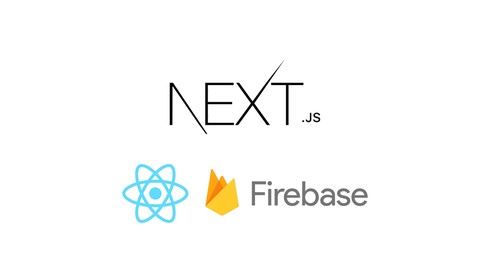
Universal React with Next.js. Complete guide – Updated 2020
Universal React with Next.js. Complete guide – Updated 2020, available at $19.99, has an average rating of 3.75, with 71 lectures, based on 36 reviews, and has 164 subscribers.
You will learn about Next js React ES6 JavaScript Web development Firebase Firebase/Firestore Firebase/Auth This course is ideal for individuals who are JavaScript developers who would like to meet the next level of programming or web developers who likes to update their knowledge about new way of writing code or Backend developers who would like to experience new way of Server Side Rendering or Frontend developers who would like to take a very easy step to produce Server side rendering code or React developers who are interested to see what is coming in their way soon It is particularly useful for JavaScript developers who would like to meet the next level of programming or web developers who likes to update their knowledge about new way of writing code or Backend developers who would like to experience new way of Server Side Rendering or Frontend developers who would like to take a very easy step to produce Server side rendering code or React developers who are interested to see what is coming in their way soon.
Enroll now: Universal React with Next.js. Complete guide – Updated 2020
Summary
Title: Universal React with Next.js. Complete guide – Updated 2020
Price: $19.99
Average Rating: 3.75
Number of Lectures: 71
Number of Published Lectures: 71
Number of Curriculum Items: 71
Number of Published Curriculum Objects: 71
Original Price: £19.99
Quality Status: approved
Status: Live
What You Will Learn
- Next js
- React
- ES6
- JavaScript
- Web development
- Firebase
- Firebase/Firestore
- Firebase/Auth
Who Should Attend
- JavaScript developers who would like to meet the next level of programming
- web developers who likes to update their knowledge about new way of writing code
- Backend developers who would like to experience new way of Server Side Rendering
- Frontend developers who would like to take a very easy step to produce Server side rendering code
- React developers who are interested to see what is coming in their way soon
Target Audiences
- JavaScript developers who would like to meet the next level of programming
- web developers who likes to update their knowledge about new way of writing code
- Backend developers who would like to experience new way of Server Side Rendering
- Frontend developers who would like to take a very easy step to produce Server side rendering code
- React developers who are interested to see what is coming in their way soon
Next.js is a react framework which is very popular and a lot of big companies are using it. You can use Next.js to build universal JavaScript application. Think of react code which works for Server Side Rendering as well as Client Side Rendering and no pain when it comes to SEO.
In this course you will learn a lot of new features about this framework.
The course has been updated on Feb 2020 with Next.js v9
Course Curriculum
Chapter 1: Intro
Lecture 1: Introduction to course
Lecture 2: What are we going to build?
Lecture 3: What do you need to know before we start the course?
Lecture 4: Server Side Rendering vs Client Side Rendering
Chapter 2: Next.js introduction
Lecture 1: Whats is Next.js
Lecture 2: Hello Next.js
Lecture 3: eslint and prettier
Lecture 4: Static files
Lecture 5: Built-in CSS
Lecture 6: Shared component – The navbar
Lecture 7: SASS and Bulma
Lecture 8: Bulma continue
Chapter 3: Blog project
Lecture 1: _app.js component
Lecture 2: Page component
Lecture 3: Populate Head
Lecture 4: Working on the navigation
Lecture 5: Footer and header with style
Lecture 6: Dynamic title
Lecture 7: Sticky footer
Chapter 4: Firebase
Lecture 1: What is Firebase?
Lecture 2: Add Firebase to project
Lecture 3: Dotenv
Lecture 4: Optimise Firebase/Firestore
Lecture 5: Read data from Firestore
Lecture 6: Subscribe to Firestore for realtime changes
Lecture 7: Refactor Firestore
Lecture 8: Read a document from Firestore collection
Chapter 5: Blog project continue
Lecture 1: Blog list and blog item components
Lecture 2: Format date with moment.js
Lecture 3: Show a blog
Lecture 4: SSR with express
Lecture 5: Read a blog from Firestore
Lecture 6: NProgress
Lecture 7: Next.js configuration
Lecture 8: Show a blog continue
Lecture 9: Subscribe to blog content for realtime changes
Lecture 10: Extracting blog to separate component
Lecture 11: Firebase users collection
Lecture 12: User Avatar
Lecture 13: Create a new blog component
Lecture 14: Create a new blog to Firestore
Lecture 15: Toggle edit and view blog
Lecture 16: Fix the memory leak issue
Lecture 17: Edit a blog
Lecture 18: Edit blog with re-base
Lecture 19: Blog edit confirmation
Lecture 20: More refactoring
Lecture 21: Use re-base in home page
Lecture 22: Title and meta tags
Chapter 6: Authentication
Lecture 1: Authenticate with Google
Lecture 2: Authenticate with Facebook, Twitter and Github
Lecture 3: Auth Handler
Lecture 4: Sign in and Sing out from the navigation bar
Lecture 5: Protect routes
Chapter 7: Validation
Lecture 1: Add user dynamically when create blog
Lecture 2: Validate Local storage user
Lecture 3: Validate blog slug
Lecture 4: Update userinfo component
Lecture 5: Show message if user is not valid
Lecture 6: Update Firebase setting to prevent console errors
Lecture 7: Form validation
Chapter 8: Finalising
Lecture 1: Related blogs
Lecture 2: Better way of fetching a blog
Lecture 3: Update Firebase security rules and .env.example file
Lecture 4: What else needs to be done?
Chapter 9: Update 2020 – First reviwe
Lecture 1: Update – Intro
Lecture 2: Update packages
Lecture 3: Update Linting config
Lecture 4: Fix linting issues
Lecture 5: Update Next.js
Lecture 6: More fixes
Instructors
-
MoHo Khaleqi
Web developer with sharp eyes for new techs
Rating Distribution
- 1 stars: 2 votes
- 2 stars: 2 votes
- 3 stars: 5 votes
- 4 stars: 13 votes
- 5 stars: 14 votes
Frequently Asked Questions
How long do I have access to the course materials?
You can view and review the lecture materials indefinitely, like an on-demand channel.
Can I take my courses with me wherever I go?
Definitely! If you have an internet connection, courses on Udemy are available on any device at any time. If you don’t have an internet connection, some instructors also let their students download course lectures. That’s up to the instructor though, so make sure you get on their good side!
You may also like
- Best Music Production Courses to Learn in December 2024
- Best Animation Courses to Learn in December 2024
- Best Digital Illustration Courses to Learn in December 2024
- Best Renewable Energy Courses to Learn in December 2024
- Best Sustainable Living Courses to Learn in December 2024
- Best Ethical AI Courses to Learn in December 2024
- Best Cybersecurity Fundamentals Courses to Learn in December 2024
- Best Smart Home Technology Courses to Learn in December 2024
- Best Holistic Health Courses to Learn in December 2024
- Best Interior Design Courses to Learn in December 2024
- Best Nutrition And Diet Planning Courses to Learn in December 2024
- Best Yoga Instruction Courses to Learn in December 2024
- Best Stress Management Courses to Learn in December 2024
- Best Mindfulness Meditation Courses to Learn in December 2024
- Best Life Coaching Courses to Learn in December 2024
- Best Career Development Courses to Learn in December 2024
- Best Relationship Building Courses to Learn in December 2024
- Best Parenting Skills Courses to Learn in December 2024
- Best Home Improvement Courses to Learn in December 2024
- Best Gardening Courses to Learn in December 2024





















